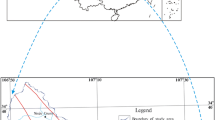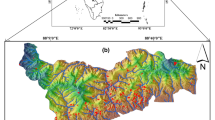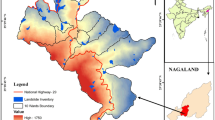Abstract
This study explores a comparative study of three susceptibility assessment models based on remote sensing (RS) and geographic information system (GIS). The Lenggu region (China) was selected as a case study. At first, a landslide inventory map was compiled using data from existing geology reports, satellite imagery, and coupling with field observations. Subsequently, three models were built to map the landslide susceptibility using analytical hierarchy process (AHP), fuzzy logic (FL) and certainty factors (CF). The resulting models were validated and compared using areas under the curve (AUC). The AUC plot estimation results indicated that the three models are promising methods for landslide susceptibility mapping. Among the three methods, CF model has highest prediction accuracy than the other two models. Similarly, the outcome of this study reveals that streams, faults, slope and elevation are the main conditioning factors of landslides. Especially, the erosion of streams plays a key role of the landslide occurrence. These landslide susceptibility maps, to some extent, reflect spatial distribution characteristics of landslides in alpine- canyon region of southwest China, and can be used for land planning and hazard risk assessment.
Similar content being viewed by others
References
Wu W, Sidle R C. A distributed slope stability model for steep forested basins [J]. Water Resources Research, 1995, 31(8): 2097–2110.
Chung C J F, Fabbri A G, Van Westen C J. Geographical Information Systems in Assessing Natural Hazards [M]. Heidelberg: Springer-Verlag, 1995.
Guzzetti F. Landslide Hazard and Risk Assessment [D]. Bonn: University of Bonn, 2005.
Lan H X, Zhou C H, Wang L J, et al. Landslide hazard spatial analysis and prediction using GIS in the Xiaojiang Watershed, Yunnan, China [J]. Engineering Geology, 2004, 76(1-2): 109–128.
Wang W D, Xie C M, Du X G. Landslides susceptibility mapping based on geographical information system, Guizhou, south-west China [J]. Environmental Geology, 2009, 58(1): 33–43.
Guo C, Montgomery D R, Zhang Y, et al. Quantitative assessment of landslide susceptibility along the Xianshuihe fault zone, Tibetan Plateau, China [J]. Geomorphology, 2015, 248: 93–110.
Cao C, Wang Q, Chen J, et al. Landslide susceptibility mapping in vertical distribution law of precipitation area: Case of the Xulong Hydropower Station Reservoir, Southwestern China [J]. Water, 2016, 8(7): 270–291.
Thanh L N, Smedt F D. Application of an analytical hierarchical process approach for landslide susceptibility mapping in A Luoi district, Thua Thien Hue Province, Vietnam [J]. Environmental Earth Sciences, 2012, 66(7): 1739–1752.
Jebur M N, Pradhan B, Tehrany M S. Optimization of landslide conditioning factors using very high-resolution airborne laser scanning (LiDAR) data at catchment scale [J]. Remote Sensing of Environment, 2014, 152: 150–165.
Kayastha P, Dhital M R, De Smedt F. Application of the analytical hierarchy process (AHP) for landslide susceptibility mapping: A case study from the Tinau watershed, west Nepal [J]. Computers & Geosciences, 2013, 52: 398–408.
Bui D T, Tuan T A, Klempe H, et al. Spatial prediction models for shallow landslide hazards: A comparative assessment of the efficacy of support vector machines, artificial neural networks, kernel logistic regression, and logistic model tree [J]. Landslides, 2016, 13(2): 361–378.
Jia N, Mitani Y, Xie M, et al. Shallow landslide hazard assessment using a three-dimensional deterministic model in a mountainous area [J]. Computers and Geotechnics, 2012, 45: 1–10.
Hasekioğulları G D, Ercanoglu M. A new approach to use AHP in landslide susceptibility mapping: A case study at Yenice (Karabuk, NW Turkey) [J]. Natural Hazards, 2012, 63(2): 1157–1179.
Yilmaz I. Comparison of landslide susceptibility mapping methodologies for Koyulhisar, Turkey: Conditional probability, logistic regression, artificial neural networks, and support vector machine [J]. Environmental Earth Sciences, 2010, 61(4): 821–836.
Xu C, Xu X, Dai F, et al. Comparison of different models for susceptibility mapping of earthquake triggered landslides related with the 2008 Wenchuan earthquake in China [J]. Computers & Geosciences, 2012, 46: 317–329.
Devkota K C, Regmi A D, Pourghasemi H R, et al. Landslide susceptibility mapping using certainty factor, index of entropy and logistic regression models in GIS and their comparison at Mugling-Narayanghat road section in Nepal Himalaya [J]. Natural Hazards, 2013, 65(1): 135–165.
Pradhan B, Buchroithner M F. Comparison and validation of landslide susceptibility maps using an artificial neural network model for three test areas in Malaysia [J]. Environmental & Engineering Geoscience, 2010, 16(2): 107–126.
Park S, Choi C, Kim B, et al. Landslide susceptibility mapping using frequency ratio, analytic hierarchy process, logistic regression, and artificial neural network methods at the Inje area, Korea [J]. Environmental Earth Sciences, 2013, 68(5): 1443–1464.
Pradhan B. A comparative study on the predictive ability of the decision tree, support vector machine and neuro-fuzzy models in landslide susceptibility mapping using GIS [J]. Computers & Geosciences, 2013, 51: 350–365.
Atkinson P M, Massari R. Generalised linear modelling of susceptibility to landsliding in the central Apennines, Italy [J]. Computers & Geosciences, 1998, 24(4): 373–385.
Reger J P. Discriminant analysis as a possible tool in landslide investigations [J]. Earth Surface Processes and Landforms, 1979, 4(3): 267–273.
Pourghasemi H R, Pradhan B, Gokceoglu C. Application of fuzzy logic and analytical hierarchy process (AHP) to landslide susceptibility mapping at Haraz watershed, Iran[J]. Natural Hazards, 2012, 63(2): 965–996.
Ermini L, Catani F, Casagli N. Artificial neural networks applied to landslide susceptibility assessment [J]. Geomorphology, 2005, 66(1): 327–343.
Yao X, Tham L G, Dai F C. Landslide susceptibility mapping based on support vector machine: A case study on natural slopes of Hong Kong, China [J]. Geomorphology, 2008, 101(4): 572–582.
Glade T. Linking debris-flow hazard assessments with geomorphology [J]. Geomorphology, 2005, 66(1): 189–213.
Qi S, Wu F, Yan F, et al. Mechanism of deep cracks in the left bank slope of Jinping First Stage Hydropower Station [J]. Engineering Geology, 2004, 73(1): 129–144.
Liu H Q, Hu R, Tan R, et al. Huashiban loose deposit landslide, Tiger-Leaping-Gorge, China: Analysis and prediction [J]. Bulletin of Engineering Geology and the Environment, 2007, 66(2): 197–202.
Wang Z L. Research on Failure Mode and Stability Analysis of the Slope at Lenggu Hydropower Station on Yalong River [D]. Chengdu: Chengdu University of Technology, 2016 (Ch).
Saaty T L. Axiomatic foundation of the analytic hierarchy process [J]. Management Science, 1986, 32(7): 841–855.
Shortliffe E H, Buchanan B G. A model of inexact reasoning in medicine [J]. Mathematical Biosciences, 1975, 23(3-4): 351–379.
Binaghi E, Luzi L, Madella P, et al. Slope instability zonation: A comparison between certainty factor and fuzzy Dempster–Shafer approaches [J]. Natural Hazards, 1998, 17(1): 77–97.
Pourghasemi H R, Pradhan B, Gokceoglu C, et al. Application of weights-of-evidence and certainty factor models and their comparison in landslide susceptibility mapping at Haraz watershed, Iran [J]. Arabian Journal of Geosciences, 2013, 6(7): 2351–2365.
Zadeh L A. Fuzzy sets [J]. Information and Control, 1965, 8(3): 338–353.
Bonham-Carter G F. Geographic Information Systems for Geoscientists: Modeling with GIS [M]. Oxford: Pergamon Press, 1994.
Wieczorek G F. Preparing a detailed landslide-inventory map for hazard evaluation and reduction [J]. Bull Assoc Eng Geol, 1984, 21(3): 337–342.
Soeters R, van Westen C J. Slope instability recognition, analysis, and zonation [J]. Transportation Research Board Special Report, 1996, (247): 129–177.
Van Westen C J, Castellanos E, Kuriakose S L. Spatial data for landslide susceptibility, hazard, and vulnerability assessment: An overview[J]. Engineering Geology, 2008, 102(3): 112–131.
Kritikos T, Davies T. Assessment of rainfall-generated shallow landslide/debris-flow susceptibility and runout using a GIS-based approach: Application to western Southern Alps of New Zealand [J]. Landslides, 2015, 12(6): 1051–1075.
Ercanoglu M, Gokceoglu C, Van Asch T W J. Landslide susceptibility zoning north of Yenice (NW Turkey) by multivariate statistical techniques [J]. Natural Hazards, 2004, 32(1): 1–23.
Dai F C, Lee C F. Landslide characteristics and slope instability modeling using GIS, Lantau Island, Hong Kong [J]. Geomorphology, 2002, 42(3): 213–228.
Donati L, Turrini M C. An objective method to rank the importance of the factors predisposing to landslides with the GIS methodology: application to an area of the Apennines (Valnerina; Perugia, Italy) [J]. Engineering Geology, 2002, 63(3): 277–289.
Yalcin A, Bulut F. Landslide susceptibility mapping using GIS and digital photogrammetric techniques: A case study from Ardesen (NE-Turkey) [J]. Natural Hazards, 2007, 41(1): 201–226.
Korup O. Geomorphic implications of fault zone weakening: Slope instability along the Alpine Fault, South Westland to Fiordland[J]. New Zealand Journal of Geology and Geophysics, 2004, 47(2): 257–267.
Warr L N, Cox S. Clay mineral transformations and weakening mechanisms along the Alpine Fault, New Zealand [J]. Geological Society, London, Special Publications, 2001, 186(1): 85–101.
Larsen I J, Montgomery D R. Landslide erosion coupled to tectonics and river incision [J]. Nature Geoscience, 2012, 5(7): 468–473.
Nefeslioglu H A, Gokceoglu C, Sonmez H. An assessment on the use of logistic regression and artificial neural networks with different sampling strategies for the preparation of landslide susceptibility maps [J]. Engineering Geology, 2008, 97(3): 171–191.
Hall F G, Townshend J R, Engman E T. Status of remote sensing algorithms for estimation of land surface state parameters [J]. Remote Sensing of Environment, 1995, 51(1): 138–156.
Chen W, Li W P, Chai H C, et al. GIS-based landslide susceptibility mapping using analytical hierarchy process (AHP) and certainty factor (CF) models for the Baozhong region of Baoji City, China [J]. Environmental Earth Sciences, 2016, 75(1): 63.
Author information
Authors and Affiliations
Corresponding author
Additional information
Foundation item: Supported by the National Natural Science Foundation of China (41602354), the Chongqing Research Program of Basic Research and Frontier Technology (2017jcyjAX0300), and the Fundamental Research Funds for the Central Universities (XDJK2016B027)
Rights and permissions
About this article
Cite this article
Hu, M., Liu, Q. & Liu, P. Susceptibility Assessment of Landslides in Alpine-Canyon Region Using Multiple GIS-Based Models. Wuhan Univ. J. Nat. Sci. 24, 257–270 (2019). https://doi.org/10.1007/s11859-019-1395-5
Received:
Published:
Issue Date:
DOI: https://doi.org/10.1007/s11859-019-1395-5
Key words
- landslide
- susceptibility assessment
- geographic information system (GIS)
- analytical hierarchy process (AHP)
- fuzzy logic (FL)
- certainty factors (CF)




